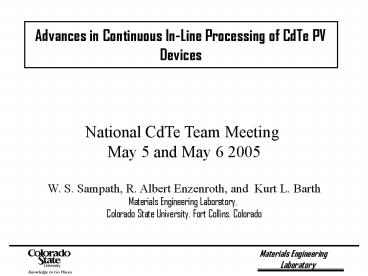Chlorine Issues - PowerPoint PPT Presentation
1 / 11
Title:
Chlorine Issues
Description:
Materials Engineering. Laboratory. Advances in Continuous In-Line Processing of CdTe PV Devices ... materials suitable for industrial processing. Nine Hour Run ... – PowerPoint PPT presentation
Number of Views:104
Avg rating:3.0/5.0
Title: Chlorine Issues
1
Advances in Continuous In-Line Processing of CdTe
PV Devices
National CdTe Team Meeting May 5 and May 6
2005 W. S. Sampath, R. Albert Enzenroth, and
Kurt L. Barth Materials Engineering Laboratory,
Colorado State University, Fort Collins, Colorado
2
Our Approach to PV Manufacturing
Process Flow and Pilot System Schematic for
Semiconductor Fabrication (1) belt conveyor, (2)
glass substrate, (3) air to vacuum to air (AVA)
seal, (4) Vacuum chamber, (5) heating module, (6)
CdS deposition, (7) CdTe deposition, (8) CdCl2
deposition and heat treatment, (9) CdCl2
annealing and stripping, (10) back contact
formation, (11) contact annealing, (12) AVA seal,
(13) cell ready for EB 003 and Electrodag 550
application (C and Ni in polymer binder) Two
Systems (a) Pilot system for 3 X 3 substrates
, and (b) Production
prototype for 16 X 16 substrates
3
Nine Hour Run with Same Source charge
Voc and Jsc during 9 hour processing with the
same source charge for CdS, CdTe and CdCl2.These
devices had no back contact (no Cu doping) but
had the back electrode (sprayed C and Ni films)
4
Nine Hour Run with Same Source charge
Efficiency distribution of devices processed over
long duration of system operation with same
source charge CdS, CdTe and CdCl2 . The source
charge materials suitable for industrial
processing.
5
Nine Hour Run with Same Source charge
Average Efficiency Vs. Accelerated Stress Time
for Three Groups of Cells. Stress conditions are
65 C, 1 sun, 5 hrs ON/ 3 hrs off. Demonstrates
Reproducibility of Stability
6
Materials for Encapsulation
- All our stress studies, to date, performed in
desiccated air - Most polymers saturate with moisture in time
duration less than the desired life of 20 years. - Can edge seal with desiccant keep moisture away
from the devices for 20 years? Modeled moisture
transmission through Truseal solar edge tape.
7
Moisture Transmission through Truseal Edge Tape.
- Assume disc is at 65C, exposed to saturated
humidity (187 torr vapor pressure for water),
disc100 sq. in., 0.050 thickness saturated. - Water transmission through 0.050 thickness
0.084 g/day (data from Truseal) - Time to saturate next 0.050 thickness 43
days (Truseal data) - Time to saturate the next 0.050 thickness86
days - Summing this way (4386129172..), time to
saturate 1 thickness 22.3 years, at 65C, one
side exposed to 187 torr water.
8
Interconnection Studies
- For scribing the TOF, the NdYAG laser has been
found to be suitable. The CdS/CdTe films
deposited on scribed surfaces provide shunt
resistance - 2. Mechanical scribing of CdS/CdTe layer has
shown low contact resistance of less then 1 ohm
for 1 cm. NdYAG laser (flash lamp) scribing from
film side, have not resulted in a clean scribe of
CdS/CdTe. More experiments on laser scribing
underway. - 3. For the isolation of the back electrode,
abrasive blasting through a mask will be
utilized.
9
2 MW/Yr. System Development
10
2 MW/Yr. System Development
- Funded by DOE-EERE and cost shared by NSC
- Loadlocks designed, constructed and partially
tested - Large area sources tested for 78 hours, thermal
uniformity /- 1.5 C at 400C - NSC designing and constructing system for
metallization
11
Future Work
- 1. Process (vapor flux, substrate temperature,
residual gas almost fully defined) except for the
back contact process. Pilot system being extended
for precise definition of back contact process. - 2. Transfer the process defined above to
production prototype and demonstrate
semiconductor processes at 2 MW/Yr. level by
12/06. - 3. Demonstrate interconnection and encapsulation
and provide modules for beta testing. - 4. Independent evaluation by outside consultants
of the cost (capital and manufacturing) for the
DOE project.































